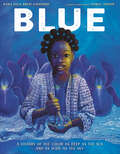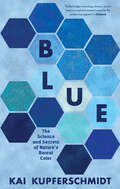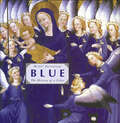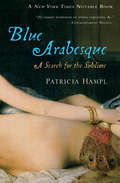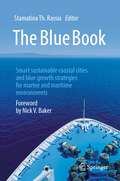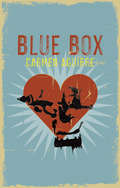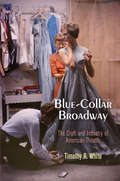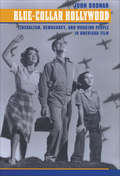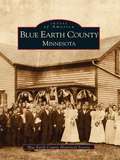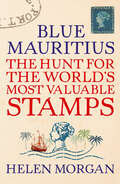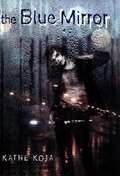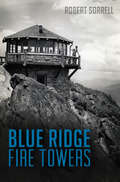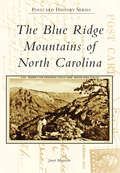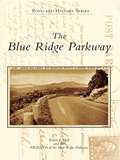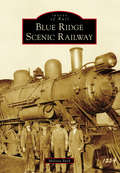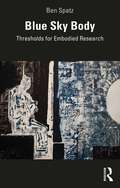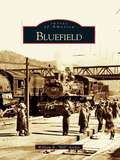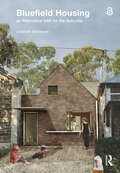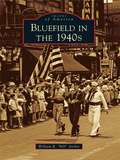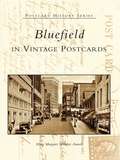- Table View
- List View
Blue: A History of the Color as Deep as the Sea and as Wide as the Sky
by Nana Ekua Brew-HammondDiscover a world of creativity and tradition in this fascinating picture book that explores the history and cultural significance of the color blue. From a critically acclaimed author and an award-winning illustrator comes a vivid, gorgeous book for readers of all ages.NAMED ONE OF THE BEST BOOKS OF THE YEAR BY NPR For centuries, blue powders and dyes were some of the most sought-after materials in the world. Ancient Afghan painters ground mass quantities of sapphire rocks to use for their paints, while snails were harvested in Eurasia for the tiny amounts of blue that their bodies would release. And then there was indigo, which was so valuable that American plantations grew it as a cash crop on the backs of African slaves. It wasn't until 1905, when Adolf von Baeyer created a chemical blue dye, that blue could be used for anything and everything--most notably that uniform of workers everywhere, blue jeans.With stunning illustrations by Caldecott Honor Artist Daniel Minter, this vibrant and fascinating picture book follows one color's journey through time and across the world, as it becomes the blue we know today.
Blue: The Science And Secrets Of Nature's Rarest Color
by Kai KupferschmidtWhat is it about the color blue? Blue is our favorite color globally—the darling of artists since the time of the pharaohs. So it’s startling to turn to the realms of nature and discover that “true” blue is truly rare. The sea and sky are blue, but we can’t bottle this trick of physics. And the few creatures, plants, and minerals that appear blue are almost all deceiving us. There’s no blue pigment in a blue jay—it would be brown but for how its feathers distort light. Kai Kupferschmidt has been enraptured by blue since childhood. In Blue, he invites readers on his globe-trotting quest to understand his favorite color— from Kyoto, where scientists are trying to engineer a blue rose, to Brandenburg, where conservationists hope to save the “little blue macaw.” Deep underground where blue crystals grow and miles overhead where astronauts gaze at our “blue marble” planet-wherever he finds this alluring color, it has a story to tell.
Blue
by Museum of Fine Arts, BostonBlue, the world's favorite color, is elegantly showcased in more than 200 artworks from the collection of the Museum of Fine Arts, Boston. Representing a diversity of movements, cultures, and media that spans the ages and the globe, the objects in Blue range from ancient Egyptian jewelry and traditional Japanese prints to Impressionist paintings and indigo-dyed textiles. Short essays from museum curators on the significance and symbolism of the color at various times and places provide historical context for this visual feast. With page edges dyed blue, this distinctive volume is a bijou treasure.
Blue: Cobalt to Cerulean in Art and Culture
by Museum of Fine Arts Boston<p>Blue, the world's favorite color, is elegantly showcased in more than 200 artworks from the collection of the Museum of Fine Arts, Boston. Representing a diversity of movements, cultures, and media that spans the ages and the globe, the objects in Blue range from ancient Egyptian jewelry and traditional Japanese prints to Impressionist paintings and indigo-dyed textiles. <p>Short essays from museum curators on the significance and symbolism of the color at various times and places provide historical context for this visual feast. With page edges dyed blue, this distinctive volume is a bijou treasure. <p>This is a fixed-format ebook, which preserves the design and layout of the original print book.</p>
Blue: The History of a Color
by Michel PastoureauA beautifully illustrated visual and cultural history of the color blue throughout the agesBlue has had a long and topsy-turvy history in the Western world. The ancient Greeks scorned it as ugly and barbaric, but most Americans and Europeans now cite it as their favorite color. In this fascinating history, the renowned medievalist Michel Pastoureau traces the changing meanings of blue from its rare appearance in prehistoric art to its international ubiquity today. Any history of color is, above all, a social history. Pastoureau investigates how the ever-changing role of blue in society has been reflected in manuscripts, stained glass, heraldry, clothing, paintings, and popular culture. Beginning with the almost total absence of blue from ancient Western art and language, the story moves to medieval Europe. As people began to associate blue with the Virgin Mary, the color became a powerful element in church decoration and symbolism. Blue gained new favor as a royal color in the twelfth century and became a formidable political and military force during the French Revolution. As blue triumphed in the modern era, new shades were created and blue became the color of romance and the blues. Finally, Pastoureau follows blue into contemporary times, when military clothing gave way to the everyday uniform of blue jeans and blue became the universal and unifying color of the Earth as seen from space.Beautifully illustrated, Blue tells the intriguing story of our favorite color and the cultures that have hated it, loved it, and made it essential to some of our greatest works of art.
Blue Arabesque: A Search for the Sublime
by Patricia HamplJust out of college, Patricia Hampl was mesmerized by a Matisse painting in the Art Institute of Chicago: an aloof woman gazing at goldfish in a bowl, a Moroccan screen behind her. In Blue Arabesque, Hampl explores the allure of this lounging woman, immersed in leisure, so at odds with the rush of the modern era. Hampl's meditation takes us to the Cote d'Azur and to North Africa, from cloister to harem, pondering figures as diverse as Eugene Delacroix, F. Scott Fitzgerald, and Katherine Mansfield. Returning always to Matisse's portraits of languid women, she discovers they were not decorative indulgences but something much more. Moving with the life force that Matisse sought in his work, Blue Arabesque is Hampl's dazzling and critically acclaimed tour de force.
The Blue Bear
by Lynn schoolerHis body twisted by adolescent scoliosis, Lynn Schooler's soul was scarred from the loneliness of someone who, at an early age, stood 'at a strange angle to the rest of the world'. He made a life on the slim crescent of remote Alaskan coastline surrounding the city of Juneau, a place where he was least likely to encounter people. In 1990, celebrated Japanese photographer Michio Hoshino hired Schooler to help him shoot a segment on humpback whales in Glacier Bay, and the two formed a profound friendship. Their conversations often revolved around the glacier bear (known as the blue bear for its unique granite-coloured fur), a nearly extinct creature so rare that it is shrouded in legend. Together the two men became obsessed with finding the animal, every year searching through Ice-Age vistas to capture the blue bear on film. Their obsession cost Hoshino his life when he was killed by a grizzly bear - but alone in the eighth year, Schooler finally found and photographed the elusive creature.
The Blue Book: Smart sustainable coastal cities and blue growth strategies for marine and maritime environments
by Stamatina Th. RassiaThis volume offers a wealth of results written by experts from interdisciplinary fields, contributing on a diversity of topics targeting marine and maritime environmental sustainability in coastal and ocean-related areas. The reader will benefit from the diversity and breadth of topical coverage as well as concepts conveyed from a variety researchers. The book serves as an open knowledge platform combining many aspects of SDG #11 including naval architecture and marine engineering, ecology, biomedical informatics, public health, architecture engineering and building physics, nanotechnology as well as advanced technologies, innovation and related fields. The broad range of topics cover ecology, shipping, and health related issues. Specifically, the book presents chapters on the following: · Shipping and ecology · Topics of ocean wildlife and mega-fauna protection · Big Data and sustainable applications for healthy and safe coastal cities · Smart sustainable humanitarian assistance methods using large vessels · Smart coastal city tourist activity, mobility management · Urban climate condition mitigation · Historical analysis of the case of disease outbreaks onboard ships · Monitoring, simulating and decision making while developing housing at sea, such as in cruise-ships · Conducting feasibility assessment for outbreak prevention following real-time, systematic disease detection on cruise ships · Technological approaches for cruise ship disease propagation monitoring · Scenario testing for sensors and actuators deployment to prevent and mitigate epidemics on cruise ships, as well as methods for improving biological safety on ships using nanotechnology The book is expected to engage researchers in multidisciplinary areas as well as students and interested readers.
Blue Box
by Carmen AguirreInterweaving recollections of her revolutionary life in Chile under Augusto Pinochet's regime with her fleeting attempts to realize a "vision" of love in Los Angeles, Carmen Aguirre's one-woman show Blue Box is a fiery proclamation of carnal yearning and social conviction. As ever, Aguirre is assertive, sexy, and wryly political, sharing the sacrifices of her life with humor and courage.Carmen Aguirre is a Vancouver-based theater artist and screen actor who has worked extensively throughout North and South America. She organizes Theatre of the Oppressed workshops and teaches in the acting department at the Vancouver Film School. Her 2011 autobiography, Something Fierce: Memoirs of a Revolutionary Daughter, is an award-winning bestseller.
Blue-Collar Broadway
by Timothy R. WhiteBehind the scenes of New York City's Great White Way, virtuosos of stagecraft have built the scenery, costumes, lights, and other components of theatrical productions for more than a hundred years. But like a good magician who refuses to reveal secrets, they have left few clues about their work. Blue-Collar Broadway recovers the history of those people and the neighborhood in which their undersung labor occurred.Timothy R. White begins his history of the theater industry with the dispersed pre-Broadway era, when components such as costumes, lights, and scenery were built and stored nationwide. Subsequently, the majority of backstage operations and storage were consolidated in New York City during what is now known as the golden age of musical theater. Toward the latter half of the twentieth century, decentralization and deindustrialization brought the emergence of nationally distributed regional theaters and performing arts centers. The resulting collapse of New York's theater craft economy rocked the theater district, leaving abandoned buildings and criminal activity in place of studios and workshops. But new technologies ushered in a new age of tourism and business for the area. The Broadway we know today is a global destination and a glittering showroom for vetted products.Featuring case studies of iconic productions such as Oklahoma! (1943) and Evita (1979), and an exploration of the craftwork of radio, television, and film production around Times Square, Blue-Collar Broadway tells a rich story of the history of craft and industry in American theater nationwide. In addition, White examines the role of theater in urban deindustrialization and in the revival of downtowns throughout the Sunbelt.
Blue-Collar Hollywood: Liberalism, Democracy, and Working People in American Film
by John BodnarSelected by Choice Magazine as an Outstanding Academic Title for 2003From Tom Joad to Norma Rae to Spike Lee's Mookie in Do the Right Thing, Hollywood has regularly dramatized the lives and struggles of working people in America. Ranging from idealistic to hopeless, from sympathetic to condescending, these portrayals confronted audiences with the vital economic, social, and political issues of their times while providing a diversion—sometimes entertaining, sometimes provocative—from the realities of their own lives.In Blue-Collar Hollywood, John Bodnar examines the ways in which popular American films made between the 1930s and the 1980s depicted working-class characters, comparing these cinematic representations with the aspirations of ordinary Americans and the promises made to them by the country's political elites. Based on close and imaginative viewings of dozens of films from every genre—among them Public Enemy, Black Fury, Baby Face, The Grapes of Wrath, It's a Wonderful Life, I Married a Communist, A Streetcar Named Desire, Peyton Place, Taxi Driver, Raging Bull, Coal Miner's Daughter, and Boyz N the Hood—this book explores such topics as the role of censorship, attitudes toward labor unions and worker militancy, racism, the place of women in the workforce and society, communism and the Hollywood blacklist, and faith in liberal democracy.Whether made during the Great Depression, World War II, the Cold War, or the Vietnam era, the majority of films about ordinary working Americans, Bodnar finds, avoided endorsing specific political programs, radical economic reform, or overtly reactionary positions. Instead, these movies were infused with the same current of liberalism and popular notion of democracy that flow through the American imagination.
Blue Earth County, Minnesota
by Blue Earth County Historical SocietyThe first white settlers came to what is now Blue Earth County in 1852, and discovered an abundance of rich land, streams, rivers, and lakes for survival in southern Minnesota. Showcasing photographs from the area's first 70 years, the Blue Earth County Historical Society has compiled over 200 images of the lifestyles and advancements of its earliest settlers.The pioneers of Blue Earth County recognized the potential for success at the bend in the Minnesota River, and forged a vibrant community out of the big woods and prairies of southern Minnesota. Pictured here are the fruits of those settlers' labors, seen in vintage images from the townships of Blue Earth County, including life on the farms and in the towns.
Blue Mauritius: The Hunt for the World's Most Valuable Stamps
by Helen MorganFollow the adventures of the world's most sought-after postage stamps—from a tropical Indian Ocean island to the hushed atmosphere of the modern auction room—in this dramatic and passionate tale of the first stamp hunters. In September 1847 colored squares of paper were stuck on to envelopes and used to send out admission cards to a fancy-dress ball on the tropical island of Mauritius. No one at the party would have guessed that these stamps would one day be worth more than a million dollars. When a two-pence "Blue Mauritius" surfaced on the fledgling French stamp-collecting market in 1865 it gained instant celebrity. Soldiers, schoolboys, and the entire German nation became obsessed with finding one of these extremely rare examples. When in 1903 a perfect specimen, discovered in a childhood album, was bought at auction by the Prince of Wales, the Blue Mauritius gained superstar status. Even now, "Post Office Mauritius" stamps are synonymous with fame, wealth, and mystery. The most coveted scraps of paper in existence, this is their story—from their birth during days of sail, taking them from Port Louis to Bordeaux, India and Great Britain, Switzerland and Japan, into the hearts and imagination of collectors everywhere.
The Blue Mirror
by Kathe KojaSeventeen-year-old loner Maggy Klass, who frequently seeks refuge from her alcoholic mother's apartment by sitting and drawing in a local cafe, becomes involved in a destructive relationship with a charismatic homeless youth named Cole.
Blue Ridge Fire Towers (Landmarks)
by Robert SorrellFire lookout towers have graced the highest peaks in the Blue Ridge Mountains for more than a century. Early mountaineers and conservationists began constructing lookouts during the late 1800s. By the 1930s, states and the federal government had built thousands of towers around the country, many in the Blue Ridge. While technology allowed forestry services to use other means for early detection of fires, many towers still stand as a testament to their significance. Author Robert Sorrell details the fascinating history of the lookouts in the Blue Ridge's forests.
Blue Ridge Mountains of North Carolina, The (Postcard History Series)
by Janet MorrisonRunning along the western border of the state, the Blue Ridge Mountains of North Carolina have beckoned explorers, settlers, and tourists for generations. Within the ridges and valleys of these mountains, spectacular natural features abound, such as Blowing Rock, Looking Glass Falls, and Linville Gorge. Here, the highest mountain peak in North Carolina, Mount Mitchell, rises to an astonishing 6,684 feet. Recreationally, these mountains boast massive tourist appeal; visitors can hike the Appalachian Trail, drive the Blue Ridge Parkway, or explore the Great Smoky Mountains National Park. This title showcases the natural beauty of the unique mountain range and the numerous mountain communities that many call home.
Blue Ridge Parkway, The
by Karen J. Hall FRIENDS of the Blue Ridge ParkwayIn the late 1890s, the Blue Ridge Parkway was envisioned by many as a great getaway and nature preserve. The concept materialized in the early 20th century, when John D. Rockefeller donated the first $5 million to begin purchasing land for the project. Located at the top of the great Appalachian ridges, the parkway covers 469 winding miles of mountains and meadows lined with lush wildflowers, old farms, and split-rail fences. Inspiring scenery makes for a journey rich in history and mountain culture.
Blue Ridge Scenic Railway
by Melissa BeckHaving whistled its first "all aboard" in 1988, the Blue Ridge Scenic Railway now rambles alongside the Toccoa's clear waters, treating 50,000-plus sightseers annually to verdant mountain scenery. This former Cherokee land's pioneers carved homesteads from rough terrain, doggedly hauling goods via mule wagon. The discovery of rich copper veins in nearby Polk County, Tennessee, attracted an influx of settlers, but before they could enjoy an Industrial Age boom including rail for faster freight movement, they would endure route changes, bankruptcies, and land-rights issues. As Fannin, Polk, and surrounding counties neared the 20th century, the long-anticipated railroad arrived, and with it prosperity. This is a photographic history of the copper miners, shop owners, homesteaders, and railroad workers who made these mountains their homes, often for many proud generations.
Blue Sky Body: Thresholds for Embodied Research
by Ben SpatzBlue Sky Body: Thresholds for Embodied Research is the follow-up to Ben Spatz's 2015 book What a Body Can Do, charting a course through more than twenty years of embodied, artistic, and scholarly research. Emerging from the confluence of theory and practice, this book combines full-length critical essays with a kaleidoscopic selection of fragments from journal entries, performance texts, and other unpublished materials to offer a series of entry points organized by seven keywords: city, song, movement, theater, sex, document, politics. Brimming with thoughtful and sometimes provocative takes on embodiment, technology, decoloniality, the university, and the politics of knowledge, the work shared here models the integration of artistic and embodied research with critical thought, opening new avenues for transformative action and experimentation. Invaluable to scholars and practitioners working through and beyond performance, Blue Sky Body is both an unconventional introduction to embodied research and a methodological intervention at the edges of contemporary theory.
Blue & White Japan
by Yutaka Satoh Amy Slyvester KatohThis delightful book shows that wherever it is used, the creative juxtaposition of blue and white provides both visual nourishment and spiritual balm. From the ephemeral beauty of a wind-blown noren curtain to the powerful geometry of zabuton cushions, to the calming symmetry of a soba cup - whether new or old, homely or sophisticated - all of these objects convey a lyrical message that speaks to our senses, inspiring us to seek out new ways to collect, create, and live with Japanese blue & white
Bluefield
by William R. ArcherThe remarkable story of Bluefield represents a unique combination of geology, geography, and opportunity. Once just the confluence of a handful of family farms in southern West Virginia, Bluefield was put on the map, literally,in the 1880s, when the Norfolk & Western Railway came to town. The company's influence on the rural landscape was overwhelming, and soon, Bluefield was transformed into the center of a coal-fired universe and became a major thoroughfare for the then-thriving mining industry. Though the company--not the coal--was king in Bluefield, enterprising men and women could, and did, share in itssuccess. The city evolved into a successful supply center for the enormous network of towns that sprung up almost overnight throughout the region's coalfields. For the next 60 years, Bluefield experienced dramatic growth, enticing a diverse group of newcomers who helped to build the strong cultural heritage that continues to play a prominent role in the community to the present day.
Bluefield Housing as Alternative Infill for the Suburbs
by Damian MadiganSuburbanised cities share a common dilemma: how to transition to more densely populated and socially connected urban systems while retaining low-rise character, avoiding gentrification, and opening neighbourhoods to more diverse housing choices. Bluefield Housing offers a new land definition and co-located infill model addressing these concerns, through describing and deploying the types of ad-hoc modifications that have been undertaken in the suburbs for decades. Extending green-, brown-, and greyfield definitions, it provides a necessary middle ground between the ‘do nothing’ attitude of suburban preservation and the ‘do everything’ approach of knock-down-rebuild regeneration. An adjunct to ‘missing middle’ and subdivision densification models, with a focus on co-locating homes on small lots, Bluefield Housing presents a unified design approach to suburban infill: retrofitting original houses, retaining and enhancing landscape and urban tree canopies, and delivering additional homes as low-rise additions and backyard homes suited to the increasingly complex make-up of our households. Extensively illustrated by the author with engaging architectural design studies, Damian Madigan describes how existing quirks of suburban housing can prompt new forms of infill, explains why a new suburban densification model is not only necessary but can be made desirable for varied stakeholders, and charts a path towards the types of statutory and market triggers required to make bluefield housing achievable. Using Australian housing as an example but addressing universal concerns around neighbourhood character, demographic needs, housing diversity, dwelling flexibility, and landscape amenity, Bluefield Housing offers innovative suburban infill ideas for policy makers, planners, architects, researchers and students of housing and design studies, and for those with a stake in the future of the suburbs.
Bluefield Housing as Alternative Infill for the Suburbs
by Damian MadiganSuburbanised cities share a common dilemma: how to transition to more densely populated and socially connected urban systems while retaining low-rise character, avoiding gentrification, and opening neighbourhoods to more diverse housing choices. Bluefield Housing offers a new land definition and co-located infill model addressing these concerns, through describing and deploying the types of ad-hoc modifications that have been undertaken in the suburbs for decades. Extending green-, brown-, and greyfield definitions, it provides a necessary middle ground between the ‘do nothing’ attitude of suburban preservation and the ‘do everything’ approach of knock-down-rebuild regeneration.An adjunct to ‘missing middle’ and subdivision densification models, with a focus on co-locating homes on small lots, Bluefield Housing presents a unified design approach to suburban infill: retrofitting original houses, retaining and enhancing landscape and urban tree canopies, and delivering additional homes as low-rise additions and backyard homes suited to the increasingly complex make-up of our households.Extensively illustrated by the author with engaging architectural design studies, Damian Madigan describes how existing quirks of suburban housing can prompt new forms of infill, explains why a new suburban densification model is not only necessary but can be made desirable for varied stakeholders, and charts a path towards the types of statutory and market triggers required to make bluefield housing achievable. Using Australian housing as an example but addressing universal concerns around neighbourhood character, demographic needs, housing diversity, dwelling flexibility, and landscape amenity, Bluefield Housing offers innovative suburban infill ideas for policy makers, planners, architects, researchers and students of housing and design studies, and for those with a stake in the future of the suburbs.The Open Access version of this book, available at www.taylorfrancis.com, has been made available under a Creative Commons Attribution-Non Commercial-No Derivatives (CC-BY-NC-ND) 4.0 license.
Bluefield in the 1940s
by William R. ArcherAlmost every American city enjoys a magical time in history when all the tumblers of fate, luck, hard work, and good fortune seem to fall into place, and the city enjoys a golden era. The 1940s were just such a time in the city of Bluefield. At the dawn of the decade, the United States was on the verge of entering the greatest war the world has ever known, and the coal that flowed through Norfolk and Western Railway's Bluefield yard was destined to fuel an Allied victory. But there is so much more than war and coal at the heart of Bluefield's story. The 1940s were a time of inspiration for men like Nobel laureate John F. Nash Jr., a time of artistic discovery for men like Joseph Dodd of Bluefield State College, a time of valor and heroism for Congressional Medal of Honor recipient S.Sgt. Junior Spurrier, and a period of success in business, arts, and professional fields for hundreds of Bluefield's sons and daughters.
Bluefield in Vintage Postcards
by Mary Margaret AnnettNestled at the foot of East River Mountain in the southern tip of West Virginia, Bluefield calls itself "Nature's Air-Conditioned City" and is a place of great cultural, industrial, and natural wealth. The early to mid-1900s were a booming time for the city, thanks to coal mining and the Norfolk and Western Railway. For the many people who lived in or traveled through the region during that era, postcards provided a simple and convenient way to send both personal correspondence and business communications. Today, Bluefield continues to change and evolve but maintains a strong sense of history, with many of its buildings and homes listed on the National Register of Historic Places.
